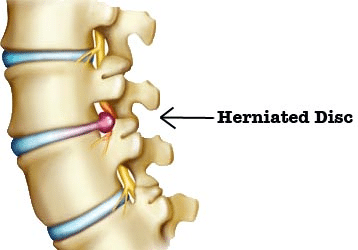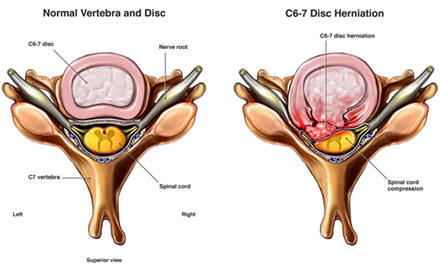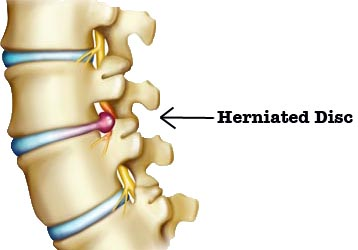It’s quite common for someone to come to me and say, “I have a herniated disk.” I used to ask how they knew, but I came to realize the answer to be unimportant. The pain and relative disability of those suffering from low back pain can be dramatic, both physically and emotionally. Being able to place a name of what’s causing that discomfort is meaningful in and of itself.
We’ve discussed low back pain (LBP) before on Straight, No Chaser, but herniated disks are special considerations among its causes. A herniated (aka ruptured or slipped) disk refers to a problem with one of the rubbery cushions (disks) between the individual bones (vertebrae) that stack up to make your spine. A common and effective way to understand a spinal disk is to picture a jelly donut, with a softer center captured inside of a tougher exterior. A herniated disk occurs when some of the softer portion protrudes through the exterior. Keep in mind that your spinal column runs from your neck down your lower back, so herniation may occur anywhere along the spine, although the low back is the most common site.
Herniated disks may or may not produce symptoms, and you may not even know you have one. Of course, some herniated disks are extremely painful and incapacitating. The problems with herniated disks aren’t just related to the manual eruption of the disk’s contents. You can experience irritation of surrounding nerves, which can produce pain, numbness or weakness in an arm or leg.
The most common signs and symptoms of a herniated disk are relative to the nerves affected by the herniation. Nerves have a distribution (i.e., affected areas of the body) associated with them. The following symptoms can be produced by a herniated disk and will be seen along that distribution.
- Arm or leg pain Arm and shoulder pain may result from herniated disks in your neck, including pain that radiates down the arm. Certain motions and actions (e.g., coughing, sneezing and neck rotation) may exacerbate your symptoms. If your herniated disk is in your lower back, intense pain may be present in your buttocks, thigh, calf and part of the foot.
- Numbness or tingling
- Weakness Similarly, muscles that are served by nerves affected by a herniated disk tend to weaken, and this may cause stumbling and other signs of lessened strength (e.g., decreased ability to lift or hold).
Factors that increase your risk of a herniated disk may include a genetic predisposition, excess weight producing ongoing stress on the apparatus of the back,and various jobs (including those involving heavy or repetitive lifting, bending, twisting, pushing or pulling).
The next post will address treatment options and self-help considerations for herniated disks.
Feel free to ask your SMA expert consultant any questions you may have on this topic.
Order your copy of Dr. Sterling’s new book Behind The Curtain: A Peek at Life from within the ER at jeffreysterlingbooks.com, iTunes, Amazon, Barnes and Nobles and wherever books are sold.
Thanks for liking and following Straight, No Chaser! This public service provides a sample of what http://www.SterlingMedicalAdvice.com (SMA) and 844-SMA-TALK offers. Please share our page with your friends on WordPress, like us on Facebook @ SterlingMedicalAdvice.com and follow us on Twitter at @asksterlingmd.
Copyright © 2016 · Sterling Initiatives, LLC · Powered by WordPress



